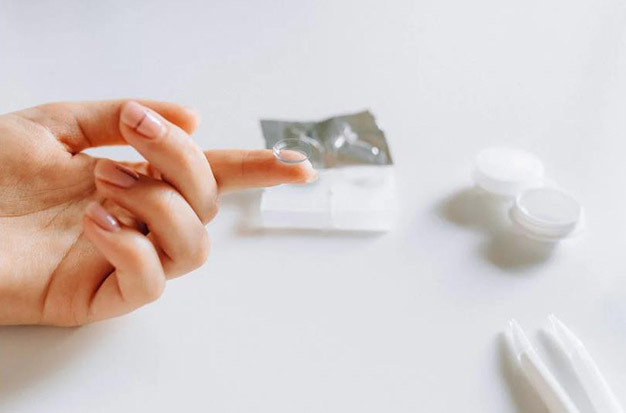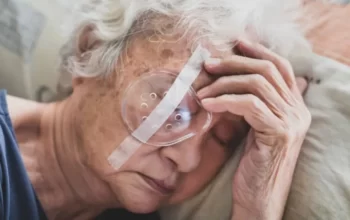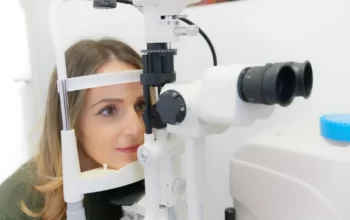
After wearing contacts for a while, you might have experienced discomfort brought on by dry eye syndrome. Your neighborhood eye doctor Nova Vision Center explains the causes of dry eyes and how to treat the condition in today’s post.
Do You Have Dry Eye Syndrome?
The hallmark of dry eye syndrome is dryness around the eyes, which can occasionally be accompanied by inflammation, irritation, or blurred vision. Because moisture prevents friction between the eyes and contact lenses, discomfort is more noticeable for contact lens wearers.
Damage to the tear glands, the skin around the eyes, certain autoimmune diseases, or hormonal changes can all lead to dry eyes. Allergies, aging, and some medications can also be the culprits. Dry eyes can also occur as a result of prolonged contact lens wear.
What Triggers Dry Eye Disease?
According to the National Eye InstituteTrusted Source, almost five million Dry eye syndrome affects Americans. Causes can include:
- damage to the tear glands around the eyes
- damage to or disease of the skin around the eyes
- diseases, such as Sjogren’s syndrome and other autoimmune conditions
- medicines, such as antihistamines, certain antidepressants, blood pressure medications, and birth control pills
- hormone changes that can occur with menopause
- dry eye can also be associated with allergies and with aging eyes
Dry eye can also be brought on by frequently wearing contact lenses. According to a study in Optometry & Vision ScienceTrusted Source, about half of contact lens wearers develop contact lens-related dry eye.
It may hurt, burn, or feel gritty, as if something is in your eye if you have dry eye. Vision haze can occur for some people. Wearing contacts while suffering from dry eye may make you feel particularly uncomfortable.
If you suffer from dry eye, you are not required to stop wearing contacts. It can help to treat the underlying cause of dry eye or switch to a different kind of lens.
Are Your Contacts Causing Dry Eye?
Patients’ complaints that their contact lenses are drying out their eyes are among the more common ones that eye doctors hear. Even though dry eye syndrome (DES) is very common in both contact lens wearers and non-users, wearing contact lenses can make the symptoms worse and more uncomfortable. Red, itchy eyes are frequently one of the DES symptoms.
The best way to deal with contact lens-induced dry eye syndrome is to visit Dr. Alicia Harrison, so we can determine exactly why your eyes are dry and provide ways to increase your comfort while wearing contact lenses.
How To Treat Dry Eye Disease?
The best course of action is to consult an eye doctor to ascertain the cause of your dry eyes before beginning any medication or other preventive measures. Lubricating eye drops are frequently used to treat dry eyes, and they are effective when ineffective tear glands or abnormally low humidity levels are the roots of the issue. A change in your current prescription may be necessary for treatment if your medication is causing dry eyes.

Getting Relief For Contact-lens Induced Dry Eye
The following things can alleviate dry eye brought on by contact lenses.
- Eye drops – To ease discomfort and revive eyes, be sure to purchase eye drops that can be safely applied while wearing contact lenses. Consult a doctor if the over-the-counter eye drops for any reason fail to relieve your symptoms. Alicia Harrison is able to offer more potent therapeutic options.
- Eye vitamins – Orally ingested vitamins can boost the number of nutrients your eyes receive. This enhances contact lens comfort while also enhancing eye health. The top eye vitamins and supplements are lutein, zeaxanthin, vitamin A, vitamin c, and omega-3 fatty acids.
- Silicone hydrogel contact lenses – These lenses are created using the most cutting-edge contact lens material on the market. Because they allow up to five times as much oxygen to enter the eye as older contact lenses do, they are incredibly breathable. Because of this, they can be worn continuously. They increase comfort and lessen dryness.
- Low water content contact lenses – It’s a common misconception that contact lenses are more comfortable the more water they contain. It can have the opposite effect on some wearers, especially those who have dry eyes. High water content contact lenses allow more oxygen to reach the cornea, but as they gradually lose liquid, they draw it from the tear film, worsening the symptoms of dry eye.
- Daily disposable contact lenses – Also called dailies, these single-day contact lenses are a great option for dry eye sufferers. This is due to the fact that protein deposits don’t have time to accumulate and irritate users, and lenses aren’t allowed to dry out as a result of ineffective cleaning procedures.
- Scleral lenses – By vaulting over the entire corneal surface, these large-diameter rigid gas permeable (GP) lenses prevent the front of the eyes from drying out. A constant moist environment that protects the cornea and offers comfort to people who have dry eyes is created by the liquid reservoir that sits between the lenses and the cornea.
- Would you prefer to only put on your contact lenses at night? – Orthokeratology Gas permeable contact lenses called orthokeratology (or ortho-k) are only meant to be worn at night. With the help of these lenses, you can see clearly during the day without the use of contacts or glasses by temporarily correcting nearsightedness and other refractive errors while you sleep. This lessens the symptoms of dry eyes brought on by contact lenses.
- Following the hygiene regimen recommended by your eye doctor – People who wear monthly lenses must follow a particular hygiene regimen suggested by their eye doctor. Your dry eye condition might be brought on by using the incorrect solution or improperly cleaning your lenses. Make sure the solution you’re using is the right one because not all multipurpose cleaning solutions are made to clean silicone hydrogel contact lenses.
You could also have sensitive eyes, in which case your symptoms of the dry eye could be an adverse reaction to the preservatives in the solution. Speak to Dr. if your eyes feel irritated despite using your usual cleaning solution. For improved comfort, Alicia Harrison will advise using a preservative-free lens solution.
How Should I Choose Contacts For My Dry Eyes?
Before beginning treatment, your doctor can assist in determining the cause of your dry eyes.
If your eyes aren’t releasing enough tears, your doctor might advise lubricating eye drops. You might need to change medications if one of the ones you’re taking is to blame. In order to keep more moisture in your eyes, a procedure is also available to block the drain system in your eyes. In serious cases, this treatment option might be provided.
You might need to try a different kind of lens if yours are the issue. Here are a few possibilities.
Lens Materials
There are various contact lens materials available. The flexible plastic used to make soft contact lenses allows oxygen to reach the eye. The harder material used to make rigid gas-permeable contact lenses also allows oxygen to pass through to the eye.
Hydrogel, a material made of water, is used to make soft lenses. There are soft lenses that can be worn for a day and then discarded. For up to 30 days, extended wear soft lenses may be worn again.
Protein deposits can cause your eyes to feel even drier, so changing your contact lenses daily helps prevent this. Consider trying disposable lenses if you struggle with dry eye.
You might also think about switching to a hydrogel lens made of silicone. Water doesn’t evaporate as quickly through these lenses as it does through others. Compared to standard hydrogel contacts, they might reduce dry eye better.
The only disposable lens brand with FDA approval to help ease dry eye discomfort is Proclear. Because of the phosphorylcholine, it contains, your eyes should stay moist and draw in water.
Lens Water Content
Depending on how much water they have, soft contact lenses fall into different categories.
Compared to lenses with low water content, those with high water content are more likely to result in dry eye. When you first insert them, they usually send more moisture to the eye, but they can dry out more quickly. Before you find a lens that works for you, you might need to experiment with ones with various water contents.
Lens Size
About 9 millimeters across is the average size of contact lenses. They only cover the iris, which is the colored portion of the eye.
Scleral contact lenses usually have a diameter of 15 to 22 millimeters. They cover a portion of the sclera, the white part of the eye. Scleral lenses are gas-permeable, allowing oxygen to reach the surface of the eye. When using this kind of lens, some people say their symptoms improve.
Tips To Avoid Dry Eye When Wearing Contact Lenses
We advise following these guidelines to avoid dry eyes or inflammation:
- Make sure an eye doctor has fitted you for contact lenses because they can determine the precise strength and curvature of the lenses you need and suggest the best options for your eyes.
- You should routinely have your eyes checked for vision acuity and overall ocular health. Get a thorough eye exam right away by contacting Laguna Eyes Dry Eye Center.
- Make sure to buy lenses with good oxygen permeability, and only high-quality lenses. People who are prone to developing dry eyes should use lenses with hyaluronan, especially silicone hydrogel lenses. Hard lenses are also highly advised as they draw very little moisture from the tear film.
- Do not wear contact lenses for prolonged periods of time until you discover a better solution. If you have dry eyes, it’s best to only wear contacts on special occasions, like outings or sporting events, and for a short period of time. When using a computer or watching TV, avoid wearing contact lenses because these activities put a strain on your eyes.
- If your eye doctor advises it, dispose of lenses daily, every two weeks, or once a month. To avoid any microbial buildup, you should also replace the contact lens containers in your contact lenses every few weeks.
- When suffering from the flu or a cold, refrain from wearing contact lenses because there is a higher risk of introducing bacteria into the eyes. If you have an eye infection like conjunctivitis (or pink eye), remove your contact lenses because bacteria can thrive very well underneath them.
Conclusion
You can choose from a range of options to relieve dry eyes.
A good place to start would be to switch to a different kind of contact lens. Another critical step is to take good care of your lenses. Maintain their cleanliness and replace them as directed. Wear your contact lenses only as long as your ophthalmologist recommends.
Before inserting your contact lenses, rewetting drops should be used to moisten your eyes. To keep your eyes moist throughout the day, use the drops frequently. Drops may be needed more frequently when you’re in a very dry environment, like a heated room in the winter. Try a brand of eye drops without preservatives if your eyes are sensitive.
After experimenting with various lenses and solutions, you might need to temporarily stop wearing your contacts if the issue persists. Rehydrate your eyes with preservative-free tears for a few days to give your eyes time to heal. Before trying the contacts once more, heed your doctor’s advice.



